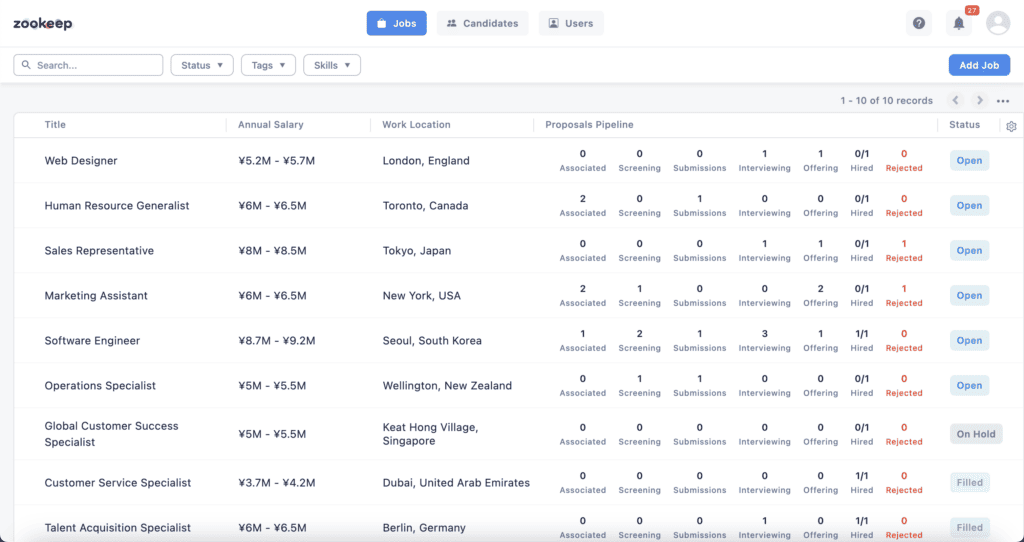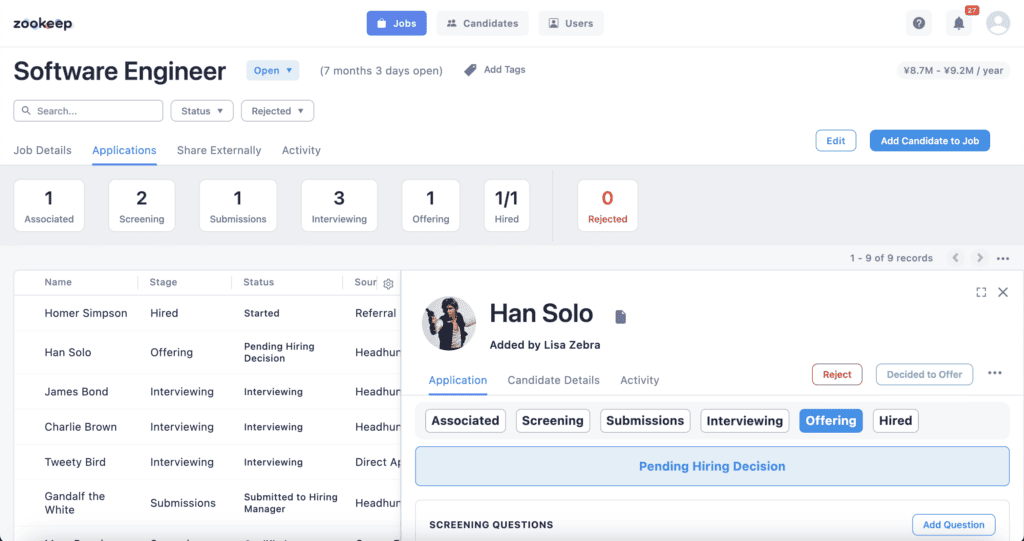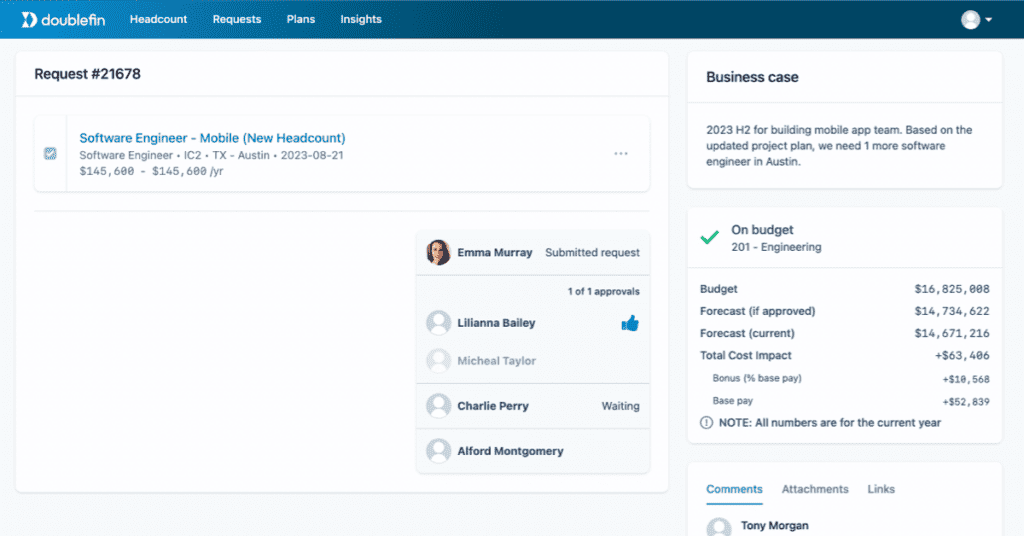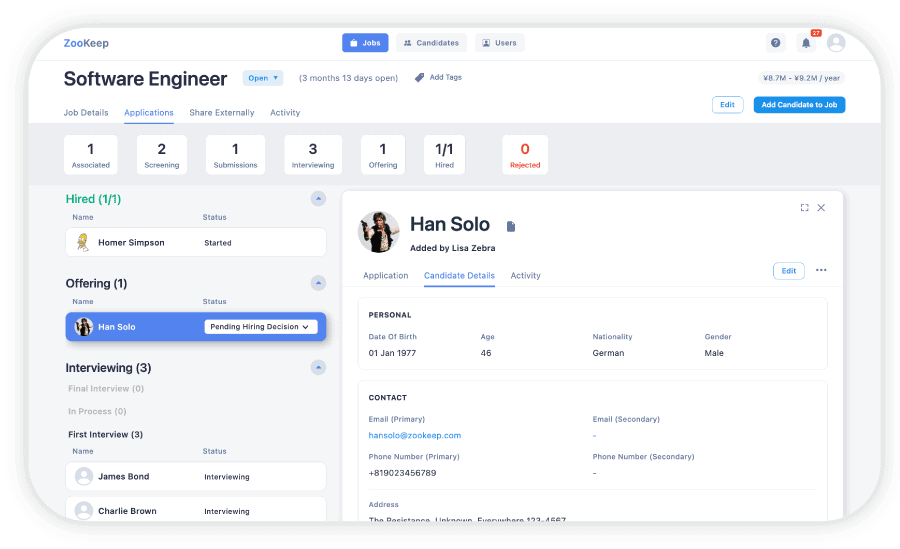In today’s competitive job market, sourcing and attracting top talent has become a top priority for organizations worldwide. With the rise of Millennials and Generation Z in the workforce, recruiters face the challenge of finding the right candidates who possess the necessary skills and align with their company culture. To address these challenges, it is crucial to develop a robust global talent acquisition strategy that includes efficient candidate sourcing techniques. In this article, we will explore the essential tips and strategies to optimize your candidate sourcing process and attract the perfect candidates for your organization.
Understanding Candidate Sourcing
Candidate sourcing is the process of searching for, identifying, and engaging with potential candidates for current or future job openings. While sourcing is just one aspect of the overall recruitment process, it plays a vital role in identifying qualified candidates who can meet the organization’s hiring needs. According to LinkedIn, 90% of people are open to learning more about new opportunities, highlighting the importance of proactive sourcing to tap into this pool of potential talent.
Key Challenges in Candidate Sourcing
Before diving into the strategies, it’s crucial to understand the challenges faced by sourcers and recruiters in candidate sourcing. Some of the common challenges include:
- Lack of candidate awareness: Candidates may not have a clear understanding of the job requirements, resulting in a mismatch between their skills and the organization’s needs.
- Low quantity or quality of applicants: Sourcing talented candidates can be challenging, especially when there is a limited pool of qualified individuals or a lack of interest in the position.
- Difficulty in contacting candidates: Reaching out to potential candidates and establishing communication can be time-consuming and challenging, leading to delays in the recruitment process.
- Competition from other companies: With organizations vying for the same pool of talent, recruiters face intense competition, making it essential to stand out and attract candidates effectively.
- Identifying effective sourcing channels: Determining the most effective platforms and job boards for sourcing candidates can be daunting, with an overwhelming number of options available.
- Managing the recruitment pipeline: Efficiently managing the recruitment pipeline, from initial sourcing to final selection, can be complex and time-consuming.
- Lack of time and lengthy time-to-hire: Recruiters often struggle with time constraints, resulting in lengthy recruitment cycles and delayed hiring decisions.
- Inadequate metrics measurement: Failing to measure and analyze the right metrics can hinder the ability to assess the effectiveness of the sourcing strategy and make data-driven improvements.
Now that we have identified the key challenges, let’s explore 12 effective strategies to optimize your global talent acquisition and enhance your candidate sourcing efforts.
1. Develop a Strategic Workforce Plan
Before embarking on your candidate sourcing journey, it is crucial to have a strategic workforce plan in place. This plan should align with your organization’s goals and objectives and identify the skills and qualities required in potential candidates. By understanding your company’s future expansion plans and anticipated skills gaps, you can develop a proactive strategy to attract and retain international talent or target new locations to fulfill specific business needs. A strategic workforce plan helps you anticipate changes, upskill your current workforce, and ensure a continuous pipeline of talent.
When creating your plan, consider the following questions:
- What are your company’s goals and expansion plans?
- Do you have any existing or anticipated skills gaps?
- What are the specific qualities and skills required in potential candidates?
- How can you develop and upskill your current workforce to bridge these gaps?
By answering these questions, you can develop an effective global talent acquisition strategy that aligns with your organization’s goals and future needs.
2. Understand Regional Job Markets
To effectively source candidates globally, it is essential to familiarize yourself with the regional job markets in different locations. Each market may have unique characteristics, including skills availability, local labor laws, cultural nuances, and preferred recruitment methods. Networking with local recruiters and understanding the local realities can help you navigate these markets effectively.
When sourcing candidates from different countries, consider the following:
- Gain insights into local hiring processes and customs to ensure you approach candidates appropriately.
- Clearly define job descriptions and qualifications to attract the right candidates.
- Understand the benefits and expectations that candidates in each market value.
- Explore specific hiring strategies for different countries to adapt to local norms and practices.
By taking the time to understand regional job markets, you can tailor your sourcing approach and increase your chances of attracting top talent from diverse locations.
3. Build a Strong Employee Value Proposition (EVP)
In a competitive talent market, it is essential to build a compelling Employee Value Proposition (EVP) to attract potential candidates. An EVP highlights the unique benefits, opportunities, and culture your organization offers to employees. By tailoring your EVP to specific regions or candidate personas, you can effectively communicate the advantages of working for your company and differentiate yourself from competitors.
When developing your EVP, consider the following:
- Identify the needs and aspirations of potential candidates in each region.
- Offer personalized value propositions that address their specific desires and expectations.
- Highlight unique aspects of your organization, such as growth opportunities, work-life balance, or impactful projects.
- Showcase testimonials or success stories from current employees to build credibility.
A well-crafted EVP can help you attract and engage candidates who align with your company culture and values, increasing the likelihood of successful hires.
4. Customize Your Outreach Strategy
To maximize the effectiveness of your candidate sourcing efforts, it is crucial to tailor your outreach strategy to each region or target audience. Different markets may respond better to specific communication channels or recruitment methods. By understanding the preferences and habits of potential candidates, you can optimize your outreach and increase response rates.
Consider the following when customizing your outreach strategy:
- Research the preferred communication channels in each region, such as LinkedIn, job boards, or social media platforms.
- Adapt your messaging and content to resonate with the local audience.
- Leverage technology tools like AI chatbots and automated communications to streamline candidate engagement.
- Monitor the effectiveness of your outreach messages and refine your approach based on response rates.
By customizing your outreach strategy, you can enhance candidate engagement and attract a higher quality of candidates.
5. Leverage the Power of Employee Referrals
Employee referrals are a valuable source of high-quality candidates. Encourage your employees to refer potential candidates who align with your organization’s requirements. Referrals can lead to faster hiring, better cultural fit, and increased retention rates. Consider implementing an employee referral program to incentivize employees to refer qualified candidates.
When leveraging employee referrals, keep the following in mind:
- Clearly communicate your referral program to employees, highlighting the benefits and incentives.
- Provide employees with the necessary tools and resources to make referrals easily.
- Regularly recognize and reward employees for successful referrals.
- Monitor the impact of employee referrals on your recruitment efforts and adjust your program accordingly.
By tapping into your employees’ networks, you can access a wider pool of qualified candidates and benefit from their recommendations.
6. Develop a Robust Sourcing Pipeline
One of the keys to successful candidate sourcing is building and maintaining a robust sourcing pipeline. This pipeline should include a mix of passive candidates and previous applicants who may be interested in future opportunities. By proactively sourcing and engaging with potential candidates, you can reduce time-to-hire and ensure a steady flow of qualified talent.
Consider the following when developing your sourcing pipeline:
- Capture and organize candidate data in an applicant tracking system (ATS) or candidate relationship management system (CRM).
- Continuously nurture relationships with passive candidates who may not be ready to make a move at the moment.
- Leverage your previous applicant pool and engage with candidates who expressed interest in your organization.
- Regularly update your sourcing pipeline with new candidates and maintain communication with existing contacts.
By building a strong sourcing pipeline, you can tap into a diverse pool of talent and expedite the hiring process when new opportunities arise.
7. Expand Your Search Horizons
To reach a wider pool of candidates, it’s crucial to expand your search beyond traditional methods. Relying solely on job boards and social media platforms may limit your reach. Explore alternative avenues and niche platforms where your target audience may be active.
Consider the following strategies to expand your search:
- Look beyond generic job titles and use specific keywords to uncover hidden talent.
- Explore industry-specific platforms, forums, and communities where professionals gather.
- Attend industry conferences, events, and networking sessions to connect with potential candidates.
- Engage with professional organizations and associations to access specialized talent pools.
By thinking outside the box and broadening your search horizons, you can discover untapped talent and gain a competitive edge.
8. Embrace Technology and AI in Sourcing
Technology, including artificial intelligence (AI), can significantly enhance your candidate sourcing efforts. Automated sourcing tools can streamline the process of finding and evaluating candidates, saving time and improving accuracy.
Consider the following technology-driven sourcing practices:
- Utilize AI-powered sourcing platforms that automate candidate search and engagement.
- Leverage machine learning algorithms to identify patterns and recommend candidates who match job requirements.
- Implement applicant tracking systems (ATS) or CRM systems to efficiently manage candidate data and streamline communication.
- Use AI chatbots for initial candidate interactions and screening processes.
By embracing technology and AI, you can optimize your sourcing workflow, increase efficiency, and improve the overall quality of candidate sourcing.
9. Measure and Analyze Sourcing Metrics
To gauge the effectiveness of your sourcing strategy, it is crucial to measure and analyze key metrics. By tracking and analyzing data, you can identify areas for improvement, optimize your processes, and make data-driven decisions.
Consider the following metrics to measure in your sourcing process:
- Response rates: Measure the number of messages or communication attempts required to elicit a response from candidates.
- Time to nurture: Track the time it takes to engage and nurture candidates before they apply or express interest.
- Time to hire: Measure the duration from initial interview to final hiring decision for sourced candidates.
- Candidate quality: Compare the quality of sourced candidates with general applicants.
- Sourcing channel effectiveness: Evaluate the performance of different sourcing channels and platforms.
- Referral impact: Monitor the number and quality of candidates referred by employees.
By regularly analyzing these metrics, you can optimize your sourcing strategy, identify areas for improvement, and make informed decisions to enhance your talent acquisition efforts.
10. Build an Inclusive Company Culture
Creating an inclusive company culture is essential to attract and retain top talent, regardless of their background or location. An inclusive culture promotes diversity, fosters collaboration, and empowers employees to thrive and contribute their best work. By actively cultivating an inclusive environment, you can appeal to a broader range of candidates and create a positive employer brand.
Consider the following strategies to build an inclusive company culture:
- Develop diversity and inclusion programs that celebrate and embrace differences.
- Provide cultural awareness training to employees to foster understanding and promote inclusivity.
- Establish employee resource groups or affinity networks to support underrepresented groups.
- Regularly assess company policies and practices for potential biases and take corrective actions.
By prioritizing an inclusive culture, you can attract diverse talent and create an environment where all employees feel valued and engaged.
11. Keep It Personal: Engage with Candidates
Effective candidate sourcing goes beyond simply identifying potential candidates; it involves building meaningful connections and engaging with them. Personalized and targeted communication can significantly increase response rates and foster a positive candidate experience.
Consider the following engagement strategies:
- Tailor your outreach messages to each candidate, highlighting their unique skills and qualifications.
- Leverage technology tools to automate personalized communications and follow-ups.
- Be responsive and timely in your communication, addressing candidate inquiries and concerns promptly.
- Provide relevant and engaging content that showcases your company culture and values.
By keeping the candidate experience at the forefront and engaging with candidates personally, you can build strong relationships and increase the likelihood of successful hires.
12. Continuously Adapt and Improve
Lastly, it is crucial to continuously adapt and improve your candidate sourcing strategy. The recruitment landscape is constantly evolving, and what works today may not be effective tomorrow. Regularly review and assess your processes, experiment with new sourcing techniques, and stay informed about industry trends and best practices.
Consider the following strategies to continuously improve your sourcing efforts:
- Stay updated on emerging technologies and tools in the recruitment industry.
- Seek feedback from candidates and hiring managers to identify areas for improvement.
- Encourage collaboration and knowledge-sharing among your sourcing and recruitment teams.
- Stay informed about global talent acquisition trends and adjust your strategy accordingly.
By adopting a growth mindset and embracing continuous improvement, you can stay ahead of the competition and optimize your global talent acquisition efforts.
Conclusion
Optimizing your global talent acquisition and candidate sourcing requires a strategic approach, customized outreach, and a commitment to continuous improvement. By developing a robust sourcing strategy, understanding regional job markets, leveraging technology, and embracing inclusivity, you can attract and engage top talent from around the world. Remember to measure and analyze sourcing metrics, adapt to emerging trends, and build strong relationships with candidates to foster a positive candidate experience. With these strategies in place, you can optimize your candidate sourcing efforts and secure the best talent for your organization’s success.















